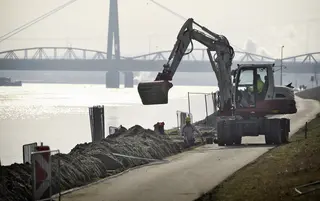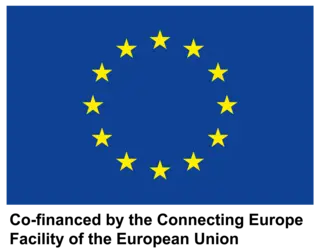The first Advisory Committee Meeting held on 9 March 2021 in a digital format kicked off two new CEF co-financed projects “Preparing FAIRway 2 works” and “FAIRway works!”. Expectations are high, as their predecessor “FAIRway Danube” is a CEF flagship initiative for coordinated Danube rehabilitation activities.
Modern navigation plus sustainable river engineering
One of the most important activities in the framework of “FAIRway works! in the Rhine-Danube Corridor” is the upgrade of the Serbian navigational lock Iron Gate II, planned for 2022-2023, which will be implemented without serious interruptions for the navigation. The current state of the lock jeopardises the safety and reliability of the operations, therefore the works foreseen in this project are essential to ensure that a Good Navigation Status is achieved and maintained. While Serbia will also procure one multifunctional marking vessel, one surveying vessel and monitored buoys in the framework of the project, the initiatives in Austria address the upgrade of three public mooring places in Linz, Wildungsmauer and Vienna. The construction works in Linz started in December 2020 and aim to improve the safety and the environmental performance of mooring operations. Another activity celebrating first success, is the procurement of multifunctional marking equipment with delivery of the lighter and contract signature for the pusher in March 2021. The new marking equipment will improve surveying data and enable faster marking operations, in particular in the free-flowing sections Wachau and East of Vienna.
While “FAIRway works! in the Rhine-Danube Corridor” focuses on the technical implementation of modernising the Danube waterway, the project „Preparing FAIRway 2 works in the Rhine-Danube Corridor“ carries out as a joint undertaking with Croatia and Serbia preparatory works for the potential river engineering measures along the critical bottlenecks on the Croatian-Serbian common Danube section.
Flagship projects with ecological responsibility
The modernisation push generated by the new cross-border projects on the Danube ensures a lot of enthusiasm among the project partners, especially due to the important cross-border connection of economic and ecological interests. Vera Hofbauer (Austrian Federal Ministry of Climate Action) is convinced that “both projects not only contribute to the realisation of the Green Deal through the promotion of Danube navigation, but will also contribute to the realisation of the biodiversity strategy by means of integrated planning on the Croatian-Serbian border stretch”.
The new Rhine-Danube Coordinator, Inés Ayala Sender, welcomes the projects in the CEF portfolio and explains that expansion of the European core transport network to the Western Balkan, as addressed by both projects, is essential for a seamless and effective transport in Europe because “transport does not stop at EU borders”.
For Herfried Leitner (Pro Danube International) the safety and reliability of the waterway are an important basis for its future. He endorses the presented projects and explains: “Danube navigation sector very much appreciates the two new project initiatives, which ensure the decrease of waiting times at the Serbian Iron Gate II locks, provide better marking and information services and enhance safety and sustainability of mooring operations.”
Arno Mohl from WWF Austria urges to act responsible in dealing with the Croatian-Serbian common Danube section and reminds: „It is one of the best-preserved Danube stretches with the largest floodplain forests along the whole Danube with a unique biodiversity and key protected areas as well as an essential part of the prospective world´s first 5-country Biosphere Reserve Mura-Drava-Danube. Hence, WWF urges that the planned interventions must not lead to any negative ecological impacts on this outstanding area.“
Guided by the Joint Statement on Inland Navigation and Environmental Sustainability in the Danube River Basin, and in compliance with the EU environmental legislation,the project partners will monitor parameters relevant to the work for the fairway upgrade together with environmental characteristics for the catalogue of biodiversity components of the common Danube section. Thecollected data will be used for modelling and multi-criteria analysis. The project will deliver models, define and prioritise critical sections for possible future works on the common Danube section and, on the basis of multi-criteria analysis, the works variants will be assessed and next steps will be defined. All activities will be done in a close cooperation with a multidisciplinary Stakeholder Forum being currently formed and including relevant experts from the inland navigation sector and nature protection NGOs.
Further to the activities on the Croatian-Serbian common Danube section, and under the coordination of viadonau (Austria), the project partners will assess requirements, identify possible measures and prepare plans for future construction and upgrading of public mooring places infrastructure in Austria, Croatia and Serbia along with the new concepts for an improved Stakeholders’ Coordination and enhancement of Waterway Monitoring System functionalities.
About the projects
Both projects are co-financed by the Connecting Europe Facility of the European Union. They aim to improve navigation conditions on the Danube and support involved countries to maintain a “Good Navigation Status” and to reach minimum requirements for rivers and canals by 2030 as set in the TEN-T Regulation (EU) No 1315/2013, while preserving a “Good Ecological Status”.
Further Information:
FAIRway Works! in the Rhine-Danube Corridor: www.fairwayworks.org
Preparing FAIRway 2 works in the Rhine-Danube Corridor: www.preparingfairway2.org


